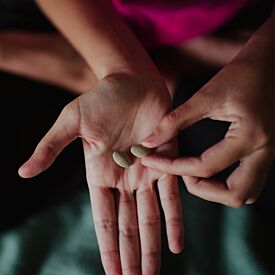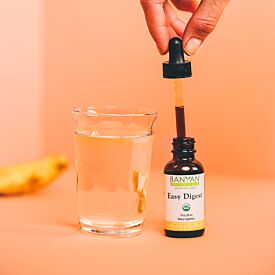Ayurvedic Wisdom for Balancing the Hormones
The wisdom tradition of Ayurveda offers a healthy and discerning approach to wholeness that can help to illuminate the complex and often overwhelming subject of hormones. Grounded in a wise understanding of the natural world, Ayurveda provides a roadmap for navigating imbalances that is comprehensive, manageable, and meaningful. Below you will find a practical and personal approach to balancing hormones using Ayurveda as an Elder.
What Are Hormones?
In the ancient Ayurvedic texts, we can only deduce the notion of hormones, since the word “hormone” didn’t emerge until 1905 when Ernest Starling coined it.1 Since the early 20th century, modern science has become incredibly adept at describing the intricate behavior of hormones, pinpointing and isolating the individual roles and functions of these chemicals that our bodies create and secrete. From these advances, we have learned that hormones are used to send communications between organs and tissues, which impact physiological regulation and behavioral activities, such as digestion, metabolism, respiration, tissue function, sensory perception, sleep, excretion, lactation, stress, growth and development, movement, reproduction, and mood.2 As Jamshed R. Tata writes, “the study of hormones has led to enormous benefits to human health, social, and economic progress.”3
Now, the advent of modern science has taught us that when we are out of balance, our hormones are out of balance. For instance, an overabundance or lack of hormones such as estrogen and progesterone, which are present during different times of the menstrual cycle, can cause a plethora of health related challenges.4 When our production of the thyroid stimulating hormone, or TSH, is low, we can develop Hashimoto’s thyroiditis. And the secretion of epinephrine and norepinephrine (the fight-or-flight hormones) are indicators of stress. Hormones, though naturally dynamic, can be clear indicators of imbalance, or vikriti, in our systems when excessively increased or depleted. You can take the Ayurvedic Profile™ quiz to get an idea of the imbalance you may be currently experiencing. We need a balance of the two kinds of hormones—“sex hormones” and “stress hormones”—in order to be and feel healthy.
In my personal journey with hormonal imbalance, I found that learning about individual hormones gave me the capability to better categorize and put into words the way I was feeling and how my feelings arose in my physical body and in my mind. I knew firmly in my bones that the experiences I felt were located at a crossroads of emotional and physical suffering, yet I did not know what to do about them or where, precisely, they were coming from.
Here’s just one example of how learning about hormones opened my eyes: Ayurveda had taught me that our menstrual cycles are cyclical and governed by the different doshas at different points. From a Western scientific viewpoint, we see that the cyclic fluctuations of hormones, like estrogens and progesterone during the menstrual cycle, can enhance the response to stress, which results in susceptibility to feelings of sadness and anxiety. Learning to identify the signs of estrogen dominance helped me attune more deeply to the time during the monthly cycle when I should pay more attention to patterns of vikriti causing this hormonal imbalance.
Fight-Or-Flight Hormones
In our day and age, stress is an epidemic. Doctors are prescribing psychiatric medications such as antidepressants and anti-anxiety medications at higher rates than ever before, with 1 in 6 people taking them.5 And 1 in 4 women now takes a psychiatric medication compared to 1 in 7 men.6 The World Health Organization estimates that depression will be the greatest cause of disability worldwide by 2020.7
The fight-flight-or-freeze reaction begins in the amygdala, with that part of the brain signaling the body to set off a cascade of hormones including cortisol, adrenaline, and norepinephrine. These hormones communicate with the rest of the body through the autonomic nervous system, which controls such involuntary body functions such as breathing, blood pressure, heartbeat, and the dilation or constriction of key blood vessels and small airways in the lungs called bronchioles.8 Pay attention to your physical body and be aware of these signs that indicate increased stress:
- Rapid breathing
- Increased heartbeat
- Hot flashes
- Racing thoughts
Executing a stress response is a sign of health—the body is displaying its ability to engage fight-flight-or-freeze, and this age-old survival mechanism of the nervous system is useful. It enabled our ancestors to protect themselves from predators, and it’s the reason we are alive today.
When an Acute Response Becomes Deep-Seated
We often live in a state where our physiological responses to minor and major stressors are skewed, and our ability to perceive safety is depleted because trauma, which occurs when the body cannot complete its fight-flight-or-freeze response, has created a somatic imprint or pattern that becomes our default. As an acute stress reaction becomes our common response to minor and major stressors, the brain begins to create a neural pathway that standardizes such a response in the face of any threat, leaving us to become chronically stressed (which is to say that our bodies are constantly producing hormones of stress).
Our collective state of chronic stress is the alarm bell for a society that is increasingly individualized and lacking in community, food that is lacking in proper nutrition, and an environment that is changing rapidly and is full of chemicals and toxins. Learning to respond to this alarm is the only way to svastha, or health.
When I was searching for healing myself, I was told by many doctors that my symptoms were a result of stress, but they could not offer much more wisdom than that.
I began to see the trauma that I had experienced, and its manifestation, in my physical symptoms.
As a person with a highly sensitive temperament and a history of trauma, I began to see the ways in which I (specifically, my nervous system) responded differently to sensory information than my peers.9 Loud sounds and smells made me uncomfortable. I was hyper-attuned to the emotional states of those around me. At first, I didn’t realize this was communication from my body, an alarm telling me to pay attention. Ultimately, I came to Ayurveda, and it was my Ayurvedic practice that allowed me to heal this chronic hormonal imbalance.
Building Resilience: Balancing Hormones with Diet
“Healing begins when we start to live the life we really want to be living.”
Ayurveda provides us with tools that can help build resilience to the hormonal imbalances we are so susceptible to. The mind and body vacillate between two states, rest and digest (parasympathetic) and fight-or-flight (sympathetic), which we can liken to prakriti, our natural state, and vikriti, imbalance. Becoming adept at listening to the patterns of vikriti that underlie our hormonal imbalances is reinforced by bringing Ayurvedic practices into our daily routine (dinacharya), and seasonal routines (rtucharya). Strengthening our ability to move in and out of states of balance with grace builds resiliency of the subtle body: prana, tejas, and ojas. Prana, tejas, and ojas are the essences of the doshas, representing subtleties of life force, light, and nourishment.
When we move from prakriti to vikriti, from parasympathetic to sympathetic, the first thing that goes offline is digestion. If there is a tiger at the door, it doesn’t matter what is for lunch. Supporting agni, the digestive fire, strengthens the communication between the body and mind through the enteric nervous system. The gut-brain, or koshta, as our only internal sensory organ, communicates with the brain (or manas) through the vagus nerve.10 In fact, the gut sends messages to the brain ten times more than the brain sends messages to the gut.11 So to begin strengthening the hormonal body, we must begin with the gross factors: the anna maya kosha, or food-body.
To best support agni, Ayurveda suggests working with herbs that kindle the digestive fire (deepana) and herbs that improve digestion (pachana) to reduce ama, or toxins, and protect the strength of agni.
3 Ways to Support Agni
- Take Easy Digest liquid extract, a wonderful tridoshic blend to help support agni
- Cook with ghee to support the intake of healthy fats
- Follow dosha-appropriate diets, reduce intake of processed food, and change diets with the season.
Learning to practice mindful eating is the most supportive practice for digestion because Ayurveda teaches us that as we eat we take in not only the food we are eating, but the emotions present as well. Reducing stress during mealtimes is most important. If you are stressed during your workday, have the smallest meal at lunch, and make breakfast the largest meal. Shifting your body’s clock to support what is practical for your stress response is one of the adjustments I have found most effective in my practice with clients.
Changing your diet is the first step to changing your life because it requires a change in the way in which you view nourishment. The majority of clients I work with have an intensely intimate and emotional relationship with food. In her book Gut, Giulia Enders speaks about the infant we once were who relied solely on the gut and brain to regulate emotions, pointing out that the two are intrinsically related. In order to heal our relationship with food, we have to become vulnerable with this very young part of ourselves. Learning to care for this part of yourself in a way that is nourishing takes an immense amount of courage and restraint.
Building Resilience: Emotions
The anna maya kosha, food-body, and the mano maya kosha, mind-body, communicate with one another through the connecting prana maya kosha, breath-body, indicating that the food sheath and the mental sheath are listening, communicating, and sharing through the subtle awareness of prana. Prana, which is directly interconnected with tejas and ojas, follows our attention, being fed by either the state of balance or the state of dis-ease we are holding. Prana, or life force, communicates directly with the hormones supplying information to the mind and body.
Ayurveda’s approach of sattvavijaya chikitsa builds emotional resiliency by teaching us to connect our individual selves to the larger macrocosm of the universe.12 When we feel a loss in connection, we have a propensity to attune to our longstanding pattern of fight-flight-or-freeze. On the other hand, when we feel connected and feel a sense of purpose, we become less stagnant in our emotions. To move towards sattva, or clarity, we must find healthy expressions of rajas (chaos) and tamas (inertia) in the mind.
This is all to say that healing the hormonal body can mean healing the emotional body. Often our most commonly experienced emotions are fear, anger, or grief. We lack creativity, innocence, and joy, and we don’t always know how to find them. Working in an integrative psychiatry clinic in Los Angeles, I have learned that healing the emotional body is not necessarily about talking and processing trauma, or about guilt and shame. It is about finding the vulnerable parts of us and integrating them into ourselves. Being willing to look at the places that scare us, and to breathe through the discomfort.
“The Buddha taught that we're not actually in control, which is a pretty scary idea. But when you let things be as they are, you will be a much happier, more balanced, compassionate person.”
What I learned most from Dr. Claudia Welch was to “treat complicated with simple.” When it comes to hormonal imbalance, we must first learn to eat and live the life we desire, and breathe through emotional discomforts to build resiliency. Stress is inevitable, but we can build our tolerance for it through resiliency.
Support Emotional Resiliency
- Stress Ease is a well-balanced formula full of adaptogenic herbs for hormone balance that supports emotional resiliency.
- Breast Care Balm, applied directly to the breasts and underarms, supports the flow of rasa. This can be a wonderful balm to also apply to the low abdomen to help move stagnation in the digestive and reproductive systems.
- Shatavari is helpful for those with a more pitta-prone hormonal imbalance.
Finally, most important to women’s hormone balance is pranayama. From a practical standpoint, it brings the body into a relaxation response, or rest and digest, meaning that it conserves energy as it slows the heart rate, increases intestinal and glandular activity, and relaxes sphincter muscles in the gastrointestinal tract.13 This guide to pranayama is a helpful resource.
Hormone Health is Non-Linear
Hormones are the messengers communicating between the mind and body. When we slow down enough to become aware of their messages, we can become deeply attuned to what it is we need—and what we need is often more simple than we think. Ayurveda can teach us to keep our minds and bodies—and the hormones that govern them—in balance. When dealing with significant imbalance, it is wise to seek the guidance of a practitioner or doctor to support your healing journey, because we cannot be our own mirrors. Shifting your perspective to view all signs of balance and imbalance as information to pay attention to with wisdom and compassion is listening to the Ayur-Vidya, or the teacher within.












